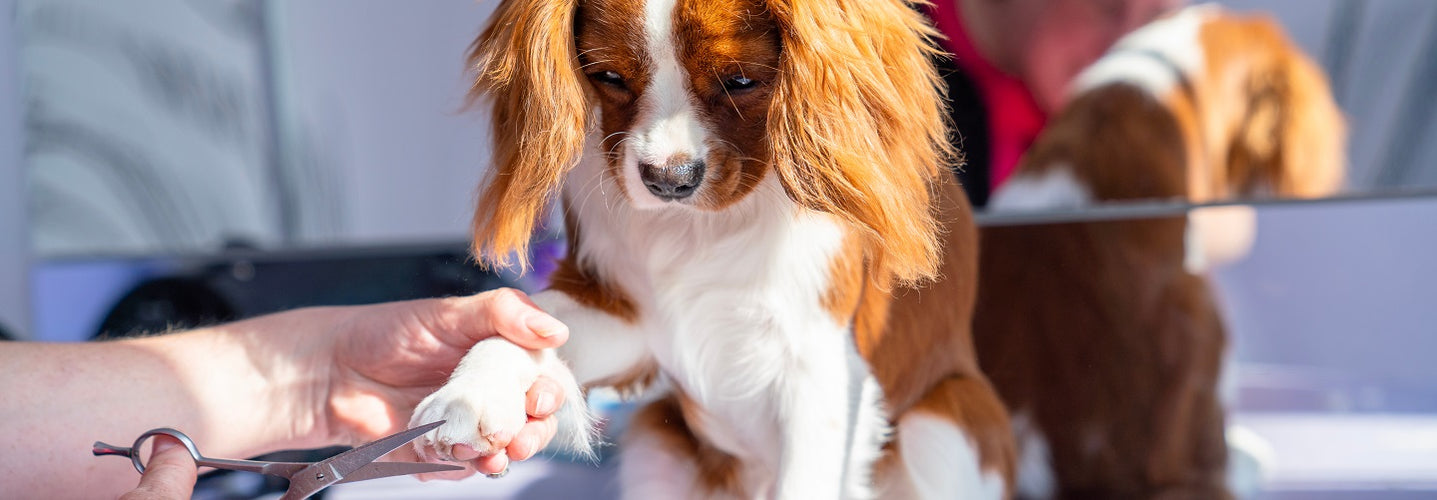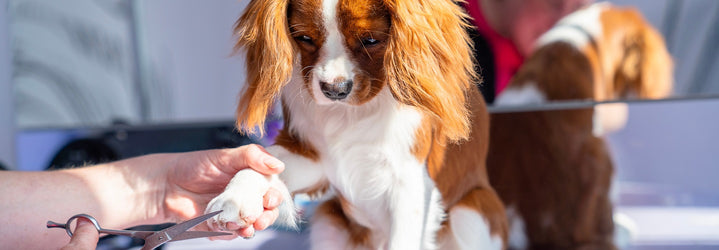

Posted by Kerry Senior Salon Manager, on
At Home Grooming Guide: Nail Trimming
When it comes to nail trimming, it can be a hard task for pet parents to undertake on a regular basis. Whether your dog get’s nervous around the clippers, they won’t stay still long enough, or their nails need more than just a quick trim; here at Pets & Friends we’re here to help you ensure your dog’s nails are at their best.
Why do I need to trim my dog’s nails?
It’s vital to maintain a healthy nail length for many reasons. The most important reason being is that a dog’s entire gait and posture can be affected if their nails are too long.
When your dog walks and their nails tap the floor, this can put pressure on the nail bed and can cause discomfort to the dog, forcing your dog to distribute their weight differently whilst they walk. This can cause short term discomfort to your dog, but it can also have a long-term effect on their joints.
How often do I need to trim my dog’s nails?
Just like human nails, dog nails also continuously grow. Depending on your dog’s lifestyle and breed will depend on how often your dog’s nails will need to be trimmed.
For example, a dog that is walked on the pavement or runs on rough ground such as concrete will typically wear their nails down much quicker than a dog that is walked on softer, grassy terrain.
What is the quick?
Something to take note of is the quick. This is a blood vessel inside the nail and continues to grow if the nail is not maintained. If your dog has light coloured nails, you may be able to see the quick, it is pink and follows the shape of the nail. If your dog has black nails, it is often hard to see the quick.
What if my dog doesn’t like having their nails trimmed?
Unsurprisingly, many dogs are not comfortable having their nails trimmed. If your dog is nervous or you are unsure how to approach nail trimming, we would always suggest visiting your local dog grooming salon to have them done professionally. Your dog will be comfortably restrained during the process and can help alleviate stress for both you and your dog when it’s been taken care of.

Can I train my dog to have their nails trimmed?
It is important to note that teaching your dog to comfortably have their nails trimmed is not something that will happen quickly. In this post we will explore the 'scratchboard' method and why it is important to maintain healthy nail length.
This kind of training will require shaping. Shaping a behaviour simply means to break down the desired behaviour into tiny increments and positively reinforce the dog at each step until your dog can confidently reach the complete behaviour, so don’t worry if your dog isn’t getting it right away- it takes time!
How to make a scratchboard.
To make a scratchboard, get a sturdy piece of wood that is suitable for the size of your dog. Apply a sandpaper sheet to the wooden board by either gluing, taping, or screwing it safely onto the board. Start off with fine grain sandpaper sheets in the beginning as the sensation will probably feel a little strange for your dog.
▪️ Step one- place the scratchboard on the floor and hold a treat in your hand (smelly treats work best). Place your hand on the scratchboard and encourage your dog to get the treat but don't allow them to eat just yet! Keep your hand on the board and withhold the treat from your dog, your dog will sniff the treat and eventually paw at it to get the treat out of your hand. As soon as your dog paws at your hand say "scratch" and release the treat immediately!
▪️ Step two- after you have repeated step one multiple times and your dog understands what "scratch" means, you can begin to raise the board slightly off the floor. Ask your dog to scratch and move the treat near to the top of the board to encourage them to scratch. Ask for a "scratch" and reward.
▪️ Step three- try to angle the board at 45° for optimum nail filing and encourage your dog to drag their paw all the way down the board. Ask for a scratch and reward.
When you begin training this nail filing technique, it is often best to reward the behaviour you want to see and practise accuracy later to ensure your dog knows what it is you're asking of them.
Ensure you check your dog’s nails regularly to make sure they're not filed too short.
End your training session on a positive note by asking your dog to do something you know they will succeed at and reward. But most importantly, make sure training sessions are short, fun, and manageable for the dog!
If your dog is showing signs of anxiety or is distressed always stop the training immediately. You can shop our at-home nail trimming products online, or speak to our pet experts about grooming and training.
